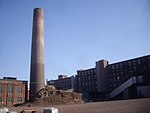Passaic Machine Works-Watts, Campbell & Company

Passaic Machine Works-Watts, Campbell & Company, is located in Newark, Essex County, New Jersey, United States. The building was added to the National Register of Historic Places on August 13, 1986. Historically, Watts Campbell specialized in building steam engines and in rebuilding old machines. In its earlier days, the factory was about twice its current size and even included a metal casting division for factory orders. It was divided into two sections. The section abutting the Passaic River, now demolished, was the metal casting division. The section currently abutting McCarter Highway, still extant, was the metal fabrication division. At its height, it employed over 330 machinists from the local area. It served Newark's industries and many other factories in the region. Customers ranged from Thomas Edison Labs to Campbell Soup Company. Watts Campbell was not unique in size. Even as late as 1950, many specialized factories surpassed Watts Campbell in size.
Excerpt from the Wikipedia article Passaic Machine Works-Watts, Campbell & Company (License: CC BY-SA 3.0, Authors, Images).Passaic Machine Works-Watts, Campbell & Company
East Mill Street, Newark
Geographical coordinates (GPS) Address Nearby Places Show on map
Geographical coordinates (GPS)
| Latitude | Longitude |
|---|---|
| N 40.751388888889 ° | E -74.1675 ° |
Address
East Mill Street 87
07104 Newark
New Jersey, United States
Open on Google Maps










